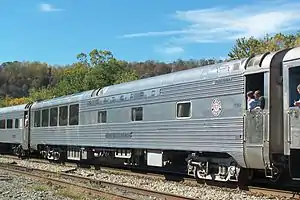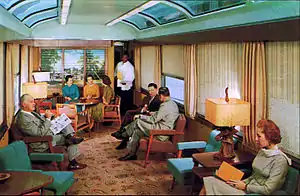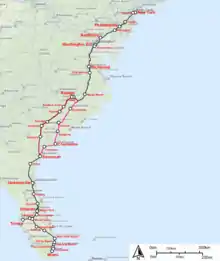Silver Meteor
The Silver Meteor is a passenger train operated by Amtrak between New York City and Miami, Florida. Introduced in 1939 as the first diesel-powered streamliner between New York and Florida, it was the flagship train of the Seaboard Air Line Railroad and one of its flagship trains of its successor, the Seaboard Coast Line. It was handed to Amtrak when it took over intercity rail service in 1971.
.jpg.webp) The Silver Meteor speeds through Odenton, Maryland. | |||||||||||||||||||||||||||||||||||||||||||||||||||||||||||||||||||||||||||||||||||||||||||||||||||||||||||||||||||||||||||||||||||||||||||||||||||||||||||||||||||||||||||||||||||||||||||||||||||||||||||||||||||||||||||||||||||||||||||||||||||||||||||||||||||||||||||||||||||||||||||||||||||||||||||||||||||||||||||||||||||||||||||||||||||||||||||||||||||||||||||||||||||||||||||||||||||||||||||||||||||
| Overview | |||||||||||||||||||||||||||||||||||||||||||||||||||||||||||||||||||||||||||||||||||||||||||||||||||||||||||||||||||||||||||||||||||||||||||||||||||||||||||||||||||||||||||||||||||||||||||||||||||||||||||||||||||||||||||||||||||||||||||||||||||||||||||||||||||||||||||||||||||||||||||||||||||||||||||||||||||||||||||||||||||||||||||||||||||||||||||||||||||||||||||||||||||||||||||||||||||||||||||||||||||
|---|---|---|---|---|---|---|---|---|---|---|---|---|---|---|---|---|---|---|---|---|---|---|---|---|---|---|---|---|---|---|---|---|---|---|---|---|---|---|---|---|---|---|---|---|---|---|---|---|---|---|---|---|---|---|---|---|---|---|---|---|---|---|---|---|---|---|---|---|---|---|---|---|---|---|---|---|---|---|---|---|---|---|---|---|---|---|---|---|---|---|---|---|---|---|---|---|---|---|---|---|---|---|---|---|---|---|---|---|---|---|---|---|---|---|---|---|---|---|---|---|---|---|---|---|---|---|---|---|---|---|---|---|---|---|---|---|---|---|---|---|---|---|---|---|---|---|---|---|---|---|---|---|---|---|---|---|---|---|---|---|---|---|---|---|---|---|---|---|---|---|---|---|---|---|---|---|---|---|---|---|---|---|---|---|---|---|---|---|---|---|---|---|---|---|---|---|---|---|---|---|---|---|---|---|---|---|---|---|---|---|---|---|---|---|---|---|---|---|---|---|---|---|---|---|---|---|---|---|---|---|---|---|---|---|---|---|---|---|---|---|---|---|---|---|---|---|---|---|---|---|---|---|---|---|---|---|---|---|---|---|---|---|---|---|---|---|---|---|---|---|---|---|---|---|---|---|---|---|---|---|---|---|---|---|---|---|---|---|---|---|---|---|---|---|---|---|---|---|---|---|---|---|---|---|---|---|---|---|---|---|---|---|---|---|---|---|---|---|---|---|---|---|---|---|---|---|---|---|---|---|---|---|---|---|---|---|---|---|---|---|---|---|---|---|---|---|---|---|---|---|---|---|---|---|---|---|---|---|---|---|---|---|---|---|---|---|---|---|---|---|---|---|---|---|---|---|---|---|---|---|---|---|---|---|---|---|---|---|---|---|---|---|---|---|---|---|---|---|---|---|---|---|---|
| Service type | Inter-city rail | ||||||||||||||||||||||||||||||||||||||||||||||||||||||||||||||||||||||||||||||||||||||||||||||||||||||||||||||||||||||||||||||||||||||||||||||||||||||||||||||||||||||||||||||||||||||||||||||||||||||||||||||||||||||||||||||||||||||||||||||||||||||||||||||||||||||||||||||||||||||||||||||||||||||||||||||||||||||||||||||||||||||||||||||||||||||||||||||||||||||||||||||||||||||||||||||||||||||||||||||||||
| Status | Operating | ||||||||||||||||||||||||||||||||||||||||||||||||||||||||||||||||||||||||||||||||||||||||||||||||||||||||||||||||||||||||||||||||||||||||||||||||||||||||||||||||||||||||||||||||||||||||||||||||||||||||||||||||||||||||||||||||||||||||||||||||||||||||||||||||||||||||||||||||||||||||||||||||||||||||||||||||||||||||||||||||||||||||||||||||||||||||||||||||||||||||||||||||||||||||||||||||||||||||||||||||||
| Locale | East Coast of the United States | ||||||||||||||||||||||||||||||||||||||||||||||||||||||||||||||||||||||||||||||||||||||||||||||||||||||||||||||||||||||||||||||||||||||||||||||||||||||||||||||||||||||||||||||||||||||||||||||||||||||||||||||||||||||||||||||||||||||||||||||||||||||||||||||||||||||||||||||||||||||||||||||||||||||||||||||||||||||||||||||||||||||||||||||||||||||||||||||||||||||||||||||||||||||||||||||||||||||||||||||||||
| First service | February 2, 1939 | ||||||||||||||||||||||||||||||||||||||||||||||||||||||||||||||||||||||||||||||||||||||||||||||||||||||||||||||||||||||||||||||||||||||||||||||||||||||||||||||||||||||||||||||||||||||||||||||||||||||||||||||||||||||||||||||||||||||||||||||||||||||||||||||||||||||||||||||||||||||||||||||||||||||||||||||||||||||||||||||||||||||||||||||||||||||||||||||||||||||||||||||||||||||||||||||||||||||||||||||||||
| Current operator(s) | Amtrak | ||||||||||||||||||||||||||||||||||||||||||||||||||||||||||||||||||||||||||||||||||||||||||||||||||||||||||||||||||||||||||||||||||||||||||||||||||||||||||||||||||||||||||||||||||||||||||||||||||||||||||||||||||||||||||||||||||||||||||||||||||||||||||||||||||||||||||||||||||||||||||||||||||||||||||||||||||||||||||||||||||||||||||||||||||||||||||||||||||||||||||||||||||||||||||||||||||||||||||||||||||
| Former operator(s) | Seaboard Air Line Railroad(1939–1967) Seaboard Coast Line Railroad(1967–1971) Pennsylvania Railroad(1939–1968, haulage agreement) Penn Central(1968–1971, haulage agreement) | ||||||||||||||||||||||||||||||||||||||||||||||||||||||||||||||||||||||||||||||||||||||||||||||||||||||||||||||||||||||||||||||||||||||||||||||||||||||||||||||||||||||||||||||||||||||||||||||||||||||||||||||||||||||||||||||||||||||||||||||||||||||||||||||||||||||||||||||||||||||||||||||||||||||||||||||||||||||||||||||||||||||||||||||||||||||||||||||||||||||||||||||||||||||||||||||||||||||||||||||||||
| Ridership | 1,023 daily 373,576 total (FY11)[1] | ||||||||||||||||||||||||||||||||||||||||||||||||||||||||||||||||||||||||||||||||||||||||||||||||||||||||||||||||||||||||||||||||||||||||||||||||||||||||||||||||||||||||||||||||||||||||||||||||||||||||||||||||||||||||||||||||||||||||||||||||||||||||||||||||||||||||||||||||||||||||||||||||||||||||||||||||||||||||||||||||||||||||||||||||||||||||||||||||||||||||||||||||||||||||||||||||||||||||||||||||||
| Route | |||||||||||||||||||||||||||||||||||||||||||||||||||||||||||||||||||||||||||||||||||||||||||||||||||||||||||||||||||||||||||||||||||||||||||||||||||||||||||||||||||||||||||||||||||||||||||||||||||||||||||||||||||||||||||||||||||||||||||||||||||||||||||||||||||||||||||||||||||||||||||||||||||||||||||||||||||||||||||||||||||||||||||||||||||||||||||||||||||||||||||||||||||||||||||||||||||||||||||||||||||
| Start | New York City | ||||||||||||||||||||||||||||||||||||||||||||||||||||||||||||||||||||||||||||||||||||||||||||||||||||||||||||||||||||||||||||||||||||||||||||||||||||||||||||||||||||||||||||||||||||||||||||||||||||||||||||||||||||||||||||||||||||||||||||||||||||||||||||||||||||||||||||||||||||||||||||||||||||||||||||||||||||||||||||||||||||||||||||||||||||||||||||||||||||||||||||||||||||||||||||||||||||||||||||||||||
| Stops | 33 | ||||||||||||||||||||||||||||||||||||||||||||||||||||||||||||||||||||||||||||||||||||||||||||||||||||||||||||||||||||||||||||||||||||||||||||||||||||||||||||||||||||||||||||||||||||||||||||||||||||||||||||||||||||||||||||||||||||||||||||||||||||||||||||||||||||||||||||||||||||||||||||||||||||||||||||||||||||||||||||||||||||||||||||||||||||||||||||||||||||||||||||||||||||||||||||||||||||||||||||||||||
| End | Miami, Florida | ||||||||||||||||||||||||||||||||||||||||||||||||||||||||||||||||||||||||||||||||||||||||||||||||||||||||||||||||||||||||||||||||||||||||||||||||||||||||||||||||||||||||||||||||||||||||||||||||||||||||||||||||||||||||||||||||||||||||||||||||||||||||||||||||||||||||||||||||||||||||||||||||||||||||||||||||||||||||||||||||||||||||||||||||||||||||||||||||||||||||||||||||||||||||||||||||||||||||||||||||||
| Distance travelled | 1,389 miles (2,235 km) | ||||||||||||||||||||||||||||||||||||||||||||||||||||||||||||||||||||||||||||||||||||||||||||||||||||||||||||||||||||||||||||||||||||||||||||||||||||||||||||||||||||||||||||||||||||||||||||||||||||||||||||||||||||||||||||||||||||||||||||||||||||||||||||||||||||||||||||||||||||||||||||||||||||||||||||||||||||||||||||||||||||||||||||||||||||||||||||||||||||||||||||||||||||||||||||||||||||||||||||||||||
| Service frequency | Four days a week | ||||||||||||||||||||||||||||||||||||||||||||||||||||||||||||||||||||||||||||||||||||||||||||||||||||||||||||||||||||||||||||||||||||||||||||||||||||||||||||||||||||||||||||||||||||||||||||||||||||||||||||||||||||||||||||||||||||||||||||||||||||||||||||||||||||||||||||||||||||||||||||||||||||||||||||||||||||||||||||||||||||||||||||||||||||||||||||||||||||||||||||||||||||||||||||||||||||||||||||||||||
| Train number(s) | 97–98 | ||||||||||||||||||||||||||||||||||||||||||||||||||||||||||||||||||||||||||||||||||||||||||||||||||||||||||||||||||||||||||||||||||||||||||||||||||||||||||||||||||||||||||||||||||||||||||||||||||||||||||||||||||||||||||||||||||||||||||||||||||||||||||||||||||||||||||||||||||||||||||||||||||||||||||||||||||||||||||||||||||||||||||||||||||||||||||||||||||||||||||||||||||||||||||||||||||||||||||||||||||
| On-board services | |||||||||||||||||||||||||||||||||||||||||||||||||||||||||||||||||||||||||||||||||||||||||||||||||||||||||||||||||||||||||||||||||||||||||||||||||||||||||||||||||||||||||||||||||||||||||||||||||||||||||||||||||||||||||||||||||||||||||||||||||||||||||||||||||||||||||||||||||||||||||||||||||||||||||||||||||||||||||||||||||||||||||||||||||||||||||||||||||||||||||||||||||||||||||||||||||||||||||||||||||||
| Class(es) | Reserved Coach and First-class Sleeper | ||||||||||||||||||||||||||||||||||||||||||||||||||||||||||||||||||||||||||||||||||||||||||||||||||||||||||||||||||||||||||||||||||||||||||||||||||||||||||||||||||||||||||||||||||||||||||||||||||||||||||||||||||||||||||||||||||||||||||||||||||||||||||||||||||||||||||||||||||||||||||||||||||||||||||||||||||||||||||||||||||||||||||||||||||||||||||||||||||||||||||||||||||||||||||||||||||||||||||||||||||
| Seating arrangements | Airline-style coach seating | ||||||||||||||||||||||||||||||||||||||||||||||||||||||||||||||||||||||||||||||||||||||||||||||||||||||||||||||||||||||||||||||||||||||||||||||||||||||||||||||||||||||||||||||||||||||||||||||||||||||||||||||||||||||||||||||||||||||||||||||||||||||||||||||||||||||||||||||||||||||||||||||||||||||||||||||||||||||||||||||||||||||||||||||||||||||||||||||||||||||||||||||||||||||||||||||||||||||||||||||||||
| Sleeping arrangements | Viewliner Roomette (2 beds) Viewliner Bedroom (2 beds) Viewliner Bedroom Suite (4 beds) Viewliner Accessible Bedroom (2 beds) | ||||||||||||||||||||||||||||||||||||||||||||||||||||||||||||||||||||||||||||||||||||||||||||||||||||||||||||||||||||||||||||||||||||||||||||||||||||||||||||||||||||||||||||||||||||||||||||||||||||||||||||||||||||||||||||||||||||||||||||||||||||||||||||||||||||||||||||||||||||||||||||||||||||||||||||||||||||||||||||||||||||||||||||||||||||||||||||||||||||||||||||||||||||||||||||||||||||||||||||||||||
| Catering facilities | Viewliner Dining car, Lounge car | ||||||||||||||||||||||||||||||||||||||||||||||||||||||||||||||||||||||||||||||||||||||||||||||||||||||||||||||||||||||||||||||||||||||||||||||||||||||||||||||||||||||||||||||||||||||||||||||||||||||||||||||||||||||||||||||||||||||||||||||||||||||||||||||||||||||||||||||||||||||||||||||||||||||||||||||||||||||||||||||||||||||||||||||||||||||||||||||||||||||||||||||||||||||||||||||||||||||||||||||||||
| Baggage facilities | Checked baggage available at selected stations | ||||||||||||||||||||||||||||||||||||||||||||||||||||||||||||||||||||||||||||||||||||||||||||||||||||||||||||||||||||||||||||||||||||||||||||||||||||||||||||||||||||||||||||||||||||||||||||||||||||||||||||||||||||||||||||||||||||||||||||||||||||||||||||||||||||||||||||||||||||||||||||||||||||||||||||||||||||||||||||||||||||||||||||||||||||||||||||||||||||||||||||||||||||||||||||||||||||||||||||||||||
| Technical | |||||||||||||||||||||||||||||||||||||||||||||||||||||||||||||||||||||||||||||||||||||||||||||||||||||||||||||||||||||||||||||||||||||||||||||||||||||||||||||||||||||||||||||||||||||||||||||||||||||||||||||||||||||||||||||||||||||||||||||||||||||||||||||||||||||||||||||||||||||||||||||||||||||||||||||||||||||||||||||||||||||||||||||||||||||||||||||||||||||||||||||||||||||||||||||||||||||||||||||||||||
| Rolling stock | |||||||||||||||||||||||||||||||||||||||||||||||||||||||||||||||||||||||||||||||||||||||||||||||||||||||||||||||||||||||||||||||||||||||||||||||||||||||||||||||||||||||||||||||||||||||||||||||||||||||||||||||||||||||||||||||||||||||||||||||||||||||||||||||||||||||||||||||||||||||||||||||||||||||||||||||||||||||||||||||||||||||||||||||||||||||||||||||||||||||||||||||||||||||||||||||||||||||||||||||||||
| Track gauge | 4 ft 8 1⁄2 in (1,435 mm) standard gauge | ||||||||||||||||||||||||||||||||||||||||||||||||||||||||||||||||||||||||||||||||||||||||||||||||||||||||||||||||||||||||||||||||||||||||||||||||||||||||||||||||||||||||||||||||||||||||||||||||||||||||||||||||||||||||||||||||||||||||||||||||||||||||||||||||||||||||||||||||||||||||||||||||||||||||||||||||||||||||||||||||||||||||||||||||||||||||||||||||||||||||||||||||||||||||||||||||||||||||||||||||||
| Track owner(s) | Amtrak, CSX, CFRC | ||||||||||||||||||||||||||||||||||||||||||||||||||||||||||||||||||||||||||||||||||||||||||||||||||||||||||||||||||||||||||||||||||||||||||||||||||||||||||||||||||||||||||||||||||||||||||||||||||||||||||||||||||||||||||||||||||||||||||||||||||||||||||||||||||||||||||||||||||||||||||||||||||||||||||||||||||||||||||||||||||||||||||||||||||||||||||||||||||||||||||||||||||||||||||||||||||||||||||||||||||
| |||||||||||||||||||||||||||||||||||||||||||||||||||||||||||||||||||||||||||||||||||||||||||||||||||||||||||||||||||||||||||||||||||||||||||||||||||||||||||||||||||||||||||||||||||||||||||||||||||||||||||||||||||||||||||||||||||||||||||||||||||||||||||||||||||||||||||||||||||||||||||||||||||||||||||||||||||||||||||||||||||||||||||||||||||||||||||||||||||||||||||||||||||||||||||||||||||||||||||||||||||
The train is part of Amtrak's Silver Service along with the Silver Star, another former SAL streamliner. The two trains are the remnants of the numerous long-distance trains that operated between Florida and New York for most of the 20th century.
During fiscal year 2019, the Silver Meteor carried 353,466 passengers, an increase of 4.9% from FY2018. [2] In FY2016, The train had a total revenue of $36,652,426, a decrease of 4.7% from FY2015. [3]
History
.jpg.webp)

The Seaboard Air Line Railroad (SAL) inaugurated the Silver Meteor on February 2, 1939. The name was selected via contest, with 30 people among 76,000 entrants proposing the winning name. It was the first diesel-powered streamliner to Florida, and its introduction prompted its competitor, the Atlantic Coast Line Railroad to introduce its own New York-Florida streamliner, the Champion, in December 1939. The SAL emphasized the train's modernity, referring to it as the "Train of Tomorrow" and having its first trip to Florida begin not from New York Penn Station, but from the Long Island Rail Road station at the 1939 New York World's Fair. The train used seven new cars manufactured by the Budd Company. The original schedule took 25 hours.[4][5]
The Pennsylvania Railroad carried the train from New York to Washington along its main line–now the Northeast Corridor–under a haulage agreement. Between Washington and Richmond it used the Richmond, Fredericksburg and Potomac Railroad, jointly owned by the SAL and five other railroads. From Richmond south SAL's own track was used via Raleigh, North Carolina, Columbia, South Carolina, Savannah, Georgia, Jacksonville, Florida and Ocala, Florida. Until the late 1960s the Silver Meteor split at Wildwood, Florida, with one section continuing to Miami, and the other to St. Petersburg and Sarasota-Venice on Florida's west coast.
The SAL merged with the Atlantic Coast Line Railroad to form the Seaboard Coast Line Railroad in 1967, and in 1968 the new railroad reshuffled the Florida streamliners. The Silver Meteor lost its west coast section and began serving Miami only.[6] The Pennsy merged with the New York Central Railroad to form Penn Central, which inherited the longstanding haulage agreement for the Silver Meteor. Amtrak retained the train when it took over most intercity passenger trains on May 1, 1971.
From December 17, 1971, to April 15, 1972, and September 10, 1972, to April 27, 1973, the Silver Meteor bypassed Jacksonville, running over the track between the Georgia state line and Baldwin, Florida. Between June 11 and September 10, 1972 the Silver Meteor was extended to Boston and called the Meteor. Service to St. Petersburg returned with the train splitting at Auburndale.
On several occasions during the 1970s, the Silver Meteor was combined with its old rival, the Champion. In the summer of 1972, Amtrak split the trains in Savannah, with the Champion continuing to St. Petersburg and the Meteor continuing to Miami. They were combined again for the summers of 1975, 1976 and 1977, splitting in Jacksonville. Finally, in 1979, the Champion was permanently folded into the Silver Meteor as a St. Petersburg section. Although the Champion name was preserved for a time,[7] it disappeared with the October 1, 1979 timetable.
On September 30, 1979 the Silver Meteor was rerouted between Savannah and Jacksonville over the former Atlantic Coast Line Railroad route, due to the abandonment of the old SAL route. On January 31, 1984 the Silver Meteor's Florida west coast terminus was cut back from St. Petersburg to Tampa, ending almost 100 years of rail passenger service to St. Petersburg. By October 26, 1986 the Silver Meteor had shifted to the old ACL route north of Savannah, as the abandonment of the SAL route north of Raleigh affected only the Silver Star. On June 11, 1988 the tracks between Coleman and Auburndale, Florida were abandoned, then removed to create the General James A. Van Fleet State Trail, shifting the Miami section west to Lakeland.
By the end of 1988 train numbers were 87 and 88 (to Tampa) and 97 and 98 (to Miami). The Tampa trips were later dropped and 97 and 98 are still used. By the mid-1990s the Silver Meteor made stops in Orlando.[8]
The best timing for Amtrak's Silver Meteor between Miami and New York City was 27 hours in 2008; SAL's first edition took 25 hours in 1939. Late trains often add more hours to today's schedules, most often caused by freight delays.
In the January 2011 issue of Trains Magazine this route was listed as one of five routes to be looked at by Amtrak in FY 2011 as the previous five routes (Sunset, Eagle, Zephyr, Capitol, and Cardinal) were examined in FY 2010.[9]
As of 2019, the train's dining car no longer serves freshly cooked meals in a traditional setting. They have switched to the “flexible dining” system, which consists of pre-prepared meals which are then heated at the time of purchase.[10]
Effective July 6, 2020, Amtrak has reduced the frequency of this train to four times per week as opposed to daily.[11] Southbound Silver Meteor trains depart New York Monday through Thursday, while Silver Star trains depart Friday through Sunday. Similarly, northbound Silver Meteor trains depart Miami Sunday through Wednesday, while Silver Star trains depart Miami on Thursday through Saturday.[12]
Equipment


The original Silver Meteor used lightweight cars built by the Budd Company. Three consists were needed for a daily train between New York and Miami; each had a baggage-dormitory-coach (22 seats), three 60-seat coaches, a tavern-lounge-coach (30 seats), a dining car, and a coach-observation-lounge (48 seats). Some of the coaches were owned by the Pennsylvania Railroad. Budd delivered more cars in November–December 1940, allowing daily service to St. Petersburg: three baggage-dormitory-coaches (18 seats), seven 56-seat coaches, two dining cars, and three coach-buffet-observation cars (30 seats).[13]
By the early 1960s, the SAL's Silver Meteor typically had 17 cars or more, consisting of nine Pullman sleeping cars including its highly touted glass-topped Sun Lounge introduced in 1956, several coaches, two dining cars, and an observation car with tavern.[14]
The Silver Meteor now uses Amtrak's standard long-distance single-level equipment: Viewliner baggage cars, Viewliner sleeping cars, Viewliner dining cars, Amfleet cafe-lounges and Amfleet coaches. An ACS-64 is used between New York City and Washington, D.C, while two GE P42DC diesel electric locomotives are used for power south of Washington, D.C.
A typical Silver Meteor includes:[15]
- 2 GE P42DC Diesel Locomotives (or 1 ACS-64 Electric Locomotive on the Northeast Corridor)
- 4–6 Amfleet II Coaches
- 1 Amfleet II Cafe/Lounge
- 1 Viewliner II Dining Car
- 3 Viewliner II Sleeping cars
- 1 Viewliner II baggage car or baggage-dorm
During the winter months, additional cars are added to meet demand. These longer trains forced delays in Amtrak's long-planned move to a larger station in Miami.[16]
Route details

The Silver Meteor's route covers 1,389 miles (2,235 km) between New York City and Miami, Florida. The train originates at New York's Pennsylvania Station and travels south to Washington, D.C. via Amtrak's Northeast Corridor. From there the train operates entirely over CSX track via Richmond, Virginia, Fayetteville, North Carolina, North Charleston, South Carolina, Savannah, Georgia, Jesup, Georgia, and Jacksonville, Florida. After transferring to the Central Florida Rail Corridor from DeLand to Poinciana, it returns to CSX track between Orlando and West Palm Beach before using the South Florida Rail Corridor from West Palm Beach to Miami[17]
The Silver Meteor shares much of its route with the Silver Star. However, the two trains diverge between their stops at Rocky Mount and Savannah. At Selma, North Carolina, the Silver Star turns inland to serve the Carolinas' two state capitals, Raleigh, North Carolina and Columbia, South Carolina. It also detours to serve Tampa, Florida. The daytime Palmetto uses the same route as the Silver Meteor but terminates in Savannah.[17]
In its present form, the southbound Silver Meteor leaves New York in mid-afternoon, arriving in Washington at dinner time and traveling overnight through Virginia and the Carolinas for arrival at breakfast time the following morning in Savannah, rush hour in Jacksonville, lunchtime in Orlando, and early evening in Miami. Northbound trains leave Miami just before rush hour, arriving in central Florida at lunchtime and Jacksonville in late afternoon and dinner time in Savannah, then passing through the Carolinas and Virginia overnight for arrival at breakfast time in Washington, mid-morning in Philadelphia and lunchtime in New York.
Like other long-distance trains, passengers are not allowed to travel only between stations on the Northeast Corridor on the Silver Meteor. Northbound trains only stop to discharge passengers from Fredericksburg northward, and southbound trains only stop to receive passengers from Newark to Washington. This policy is in place to make seats available for passengers making longer trips, and also due to the availability of the more frequent Northeast Regional service.
Additionally, the Silver Meteor, like the Silver Star, does not allow local travel between West Palm Beach and Miami. Southbound trains only stop to discharge passengers, while northbound trains only stop to receive passengers bound for points beyond West Palm Beach. This is due to the availability of Tri-Rail, South Florida's commuter rail system.
Station stops
See also
References
- "Amtrak Ridership Rolls Up Best-Ever Records" (PDF). Amtrak. October 13, 2011. Retrieved February 7, 2012.
- Amtrak FY19 Ridership
- Amtrak FY16 Ridership & Revenue
- Wegman, Mark (2008). American Passenger Trains and Locomotives Illustrated. Minneapolis, Minnesota: Voyageur Press. p. 90-91. ISBN 978-0-7603-3475-1.
- "Seaboard's Silver Meteor Dedicated at World's Fair". Palm Beach Daily News. January 22, 1939.
- "St. Petersburg Made West Coast Rail Hub". St. Petersburg Times. April 13, 1968.
- "Amtrak cuts Florida service". St. Petersburg Times. August 30, 1979. Retrieved September 28, 2013.
- Amtrak timetable, November 10, 1996, p. 29.
- "Amtrak's Improvement Wish List", Trains, January 2011, 20-21.
- https://www.amtrak.com/flexible-dining
- Tate, Curtis. "Amtrak to reduce New York-Florida trains starting July 6, with more cuts coming Oct. 1". USA TODAY. Retrieved July 1, 2020.
- "Silver Star and Silver Meteor Schedule Changes effective July 6, 2020". Amtrak. Retrieved July 5, 2020.
- Wayner, Robert J., ed. (1972). Car Names, Numbers and Consists. New York: Wayner Publications. p. 80. OCLC 8848690.
- "Equipment of Through Main Line and Local Trains", Seaboard Railroad Time Tables (December 16, 1961), p. 5.
- "Amtrak - Silver Meteor". Retrieved December 31, 2012.
- Chardy, Alfonso; Viglucci, Andres (October 31, 2013). "Long trains, short platforms at new Miami airport train station won't force permanent street closure". Miami Herald. Retrieved August 10, 2016.
- Amtrak. "Silver Service / Palmetto". Retrieved November 23, 2013.
- Mike Schafer, Amtrak's atlas, Trains June 1991
- PRR Chronology
- Amtrak's First Trains and Routes
- Amtrak timetable, November 14, 1971
- Amtrak timetable, late 1988 (Northeast Corridor only)
External links
 Media related to Silver Meteor at Wikimedia Commons
Media related to Silver Meteor at Wikimedia Commons- Silver Service / Palmetto – Amtrak